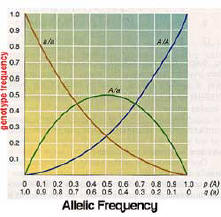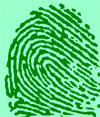|
|
||||||||||||||
|
Hardy and Weinberg worked on a
mathematical approach to population genetics and the results of their work
predict that overtime in a gene pool that is closed and allows for the
random mating of individuals within the populations the frequency of
the genes that make up the gene pool will remain constant. Let's recall the Punnet Square The mating of two black mice individuals
that are heterozygous (e.g., Bb) for a trait, we find that
|
|
|||||||||||||
 |
||||||||||||||
|
This will occur as a result of the following biological
reasons........ During gamete formation
But the frequency of two alleles in an entire population of organisms is unlikely to be exactly the same. In a population of mice in which
Random union of these gametes (right table) will produce a generation:
So 96% of this generation will have black coats;
only 4% white coats. No!
Thus we have come back to the original condition. The frequency of allele b in the population is the same as before. The heterozygous mice ensure that each generation will contain 4% white mice. Next , we look at an algebraic analysis of the same problem using expansion of the binomial (p+q)2.
The algebraic method enables us to work backward as well as forward. In fact, because we chose to make B fully dominant, the only way that the frequency of B and b in the gene pool could be known is by determining the frequency of the recessive phenotype (white) and computing from it the value of q. q2 = 0.04, so q = 0.2, the
frequency of the b allele in the gene pool. Since p + q
= 1, p = 0.8 and allele B makes up 80% of the gene pool.
Because B is completely dominant over b, we cannot
distinguish the Bb mice from the BB ones by their phenotype.
Substituting in the middle term (2pq) of the expansion gives the
percentage of heterozygous mice. 2pq = (2)(0.8)(0.2) = 0.32
This is known as the Hardy-Weinberg law in honor of the two men who first realized the significance of the binomial expansion to population genetics and hence to evolution. Evolution involves changes in
the gene pool.
|
||||||||||||||


